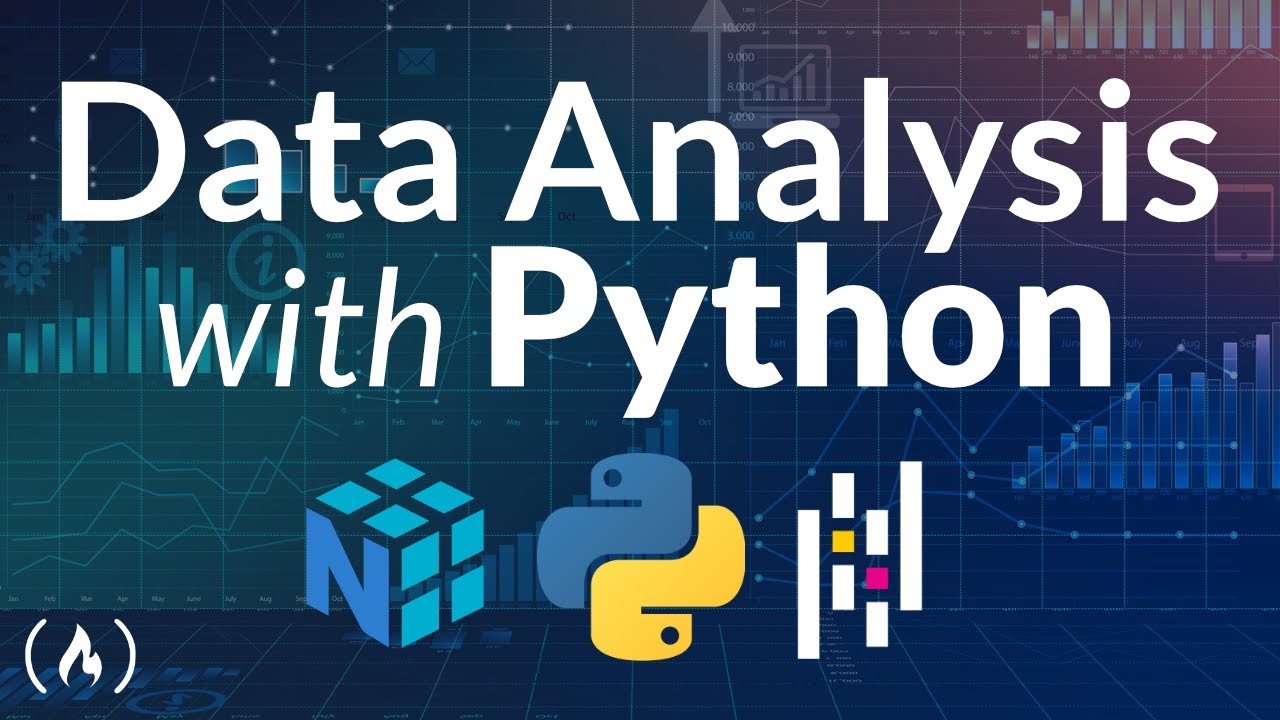
Data Analysis with Python
This Data Analysis with Python course is designed to teach students how to analyze data using Python programming language. The course will cover the basics of data analysis, including data cleaning, visualization, and statistical modeling using popular Python libraries such as Pandas, NumPy, and Matplotlib.
Overview

Data Analysis with Python
Course Learning Outcomes (CLOs) and SLOs
Course Learning Outcomes (CLOs) typically include:
Python Programming Skills: Develop proficiency in using Python libraries and tools specifically for data analysis, such as Pandas, NumPy, and Matplotlib.
Data Manipulation: Learn techniques to manipulate, clean, and preprocess data sets for analysis using Python.
Statistical Analysis: Apply statistical methods and techniques to analyze and interpret data using Python libraries.
Data Visualization: Gain expertise in visualizing data effectively using Python libraries like Matplotlib and Seaborn.
Student Learning Outcomes (SLOs) are specific goals for students, such as:
Data Cleaning and Preparation: Clean and preprocess raw data to prepare it for analysis using Python scripting and libraries.
Statistical Analysis Proficiency: Apply statistical methods to analyze datasets, derive insights, and interpret results using Python.
Visualization Skills: Create clear and informative visual representations of data using Python's visualization libraries.
Project Implementation: Execute data analysis projects using Python, from data acquisition to presentation of findings, demonstrating proficiency in applying learned skills.

Benefits
With AI, the world is your oyster! It is an emerging field, rapidly growing, ever evolving and watched with a keen eye by industries and markets globally. There are many benefits to an education in AI:
In demand Career
With a Bachelor in artificial intelligence you are equipped with in-demand skills in the rapidly growing field of AI. Knowledge of developing AI systems, data analysis and AI techniques makes you valuable across industries, right from healthcare, finance, tech and more. This degree prepares you for career that has multiple options for diversification. AI professionals include AI engineers, data scientists, machine learning specialists, AI consultants, researchers and more. AI is transformative technology that is revolutionising the world. With an education background in AI, you are set up in an in-demand career field with an exciting future ahead!
Innovation and advancement
Applied AI is all about finding solutions and using AI systems to make life simpler. Applied AI draws on its solid foundation in Computer Science to analyse and provide solutions for real world challenges. You are prepared to address complex problems and contribute meaningfully in domains like healthcare diagnostics, fraud detection, autonomous vehicles, personalised recommendations and more. Being able to apply AI techniques for solving tasks makes for an extremely rewarding and impactful job role!
Solving real world problems
AI aims to constantly bridge the gap between natural intelligence and machine learning - it is a field of cutting edge research, innovation and advancing technology. This makes it ever evolving, with new algorithms, models and techniques being developed. By studying AI at an undergraduate level, you gain a strong foundation in AI fundamentals that help you better understand the latest advancements. You step into a career that empowers you to push the boundaries of AI, contribute to research and development and drive innovation in the field.
100% International
Study at your own pace from anywhere in the world
Recommended by 96% of our graduates
According to our latest alumni survey
50,000+ students
enrolled in Germany’s largest university
Study contents
Contents
Importing Libraries
import pandas as pd: Import the pandas library and assign it the alias pd
import numpy as np: Import the NumPy library and assign it the alias np
import matplotlib.pyplot as plt: Import the Matplotlib library and assign it the alias plt
Data Loading and Cleaning
pd.read_csv('data.csv'): Load a CSV file into a Pandas DataFrame
df.head(): Display the first few rows of a Pandas
DataFrame
df.info(): Display information about a Pandas /DataFrame, such as data types and missing values
df.dropna(): Remove rows with missing values from a Pandas DataFrame
df.fillna() : Fill missing values in a Pandas DataFrame with a specified value
Data Visualization
plt.plot(df['column1'], df['column2']): Create a line plot of two columns in a Pandas DataFrame
plt.scatter(df['column1'], df['column2']): Create a scatter plot of two columns in a Pandas DataFrame
plt.bar(df['column1'], df['column2']): Create a bar chart of two columns in a Pandas DataFrame
plt hist(df['column1']): Create a histogram of a single column in a Pandas DataFrame
Admission
Admission Criteria
Here are some key concepts and tools for data analysis with Python:
Data Preprocessing
pandas: The pandas library is a fundamental tool for data manipulation and analysis in Python. It provides data structures such as Series (1-dimensional labeled array) and DataFrame (2-dimensional labeled data structure with columns of potentially different types).
NumPy: NumPy is a library for efficient numerical computation in Python. It provides support for large, multi-dimensional arrays and matrices, and is the foundation of most scientific computing in Python.
Data Visualization
Matplotlib: Matplotlib is a popular data visualization library in Python. It provides a wide range of visualization tools for creating high-quality 2D and 3D plots.
Seaborn: Seaborn is a visualization library built on top of Matplotlib. It provides a high-level interface for creating informative and attractive statistical graphics.
Machine Learning
Scikit-learn: Scikit-learn is a machine learning library in Python that provides simple and efficient tools for data analysis, classification, regression, clustering, and more.
TensorFlow: TensorFlow is an open-source machine learning framework developed by Google. It allows you to build and train machine learning models using Python.
Statistics and Hypothesis Testing
Statsmodels: Statsmodels is a Python library that provides statistical techniques and models for data analysis, including regression analysis, time series analysis, and hypothesis testing.
SciPy: SciPy is a scientific computing library that provides functions for scientific and engineering applications, including statistics, signal processing, and optimization.
Data Manipulation and Analysis
Pandas Dataframe: Pandas Dataframe is a powerful tool for data manipulation and analysis. It allows you to perform various operations such as filtering, grouping, sorting, and merging data.
GroupBy: GroupBy is a powerful function in pandas that allows you to group data by one or more columns and perform aggregation operations.
Careers
Start you career now
Data Analyst: Analyze and interpret complex data to help organizations make informed business decisions.
Job titles: Data Analyst, Business Analyst, Financial Analyst
Data Scientist: Develop and implement predictive models to drive business growth and optimize operations.
Job titles: Data Scientist, Senior Data Scientist, Lead Data Scientist
Business Intelligence Developer: Design and develop business intelligence solutions using Python, such as dashboards, reports, and data visualizations.
Job titles: Business Intelligence Developer, BI Developer, Reporting Analyst
Data Engineer: Design, build, and maintain large-scale data systems, including ETL processes, data warehouses, and big data platforms.
Job titles: Data Engineer, Senior Data Engineer, Big Data Engineer
Quantitative Analyst: Use Python to analyze and model complex financial systems, predict market trends, and optimize investment strategies.
Job titles: Quantitative Analyst, Quant Analyst, Investment Research Analyst
Machine Learning Engineer: Design and develop machine learning models using Python to solve complex problems in areas like computer vision, natural language processing, or recommender systems.
Job titles: Machine Learning Engineer, Senior Machine Learning Engineer, AI/ML Engineer
Data Visualization Specialist: Create interactive and informative visualizations to communicate complex data insights to stakeholders.
Job titles: Data Visualization Specialist, Visualization Designer, Infographic Designer
Predictive Modeling Specialist: Develop predictive models using Python to forecast customer behavior, optimize supply chain operations, or predict equipment failure.
Job titles: Predictive Modeling Specialist, Predictive Analytics Specialist, Forecasting Analyst
Data Quality Assurance: Ensure data accuracy, integrity, and quality by developing data validation rules and testing procedures.
Job titles: Data Quality Assurance Specialist, QA Analyst, Data Integrity Specialist
Research Scientist: Conduct research in areas like machine learning, computer vision, or natural language processing using Python.
Job titles: Research Scientist, Postdoctoral Researcher, Research Associate
Student reviews
Coming Soon.
Tuition fees
All our study programmes include the following benefits
- Teaching and study material
- Marking of your end-of-module exams
- Monthly live and recorded tutorials
- Use of the online campus
- Individual study coaching
- Online exams
- Career coaching
- Learn English for free
Our global recognition

IU is recognised by WES Canada and U.S., which means your degree can be converted to points in the local system for purposes of immigration, work, or studies.

As the first EU institution in UNESCO's Global Education Coalition, IU is committed to ensuring accessible quality education to students in crisis worldwide through free online micro-credentials.
Our company partners

For over 20 years, IU has established partnerships with leading global companies. This offers you the chance to gain firsthand experience through internships and projects and allow us to adapt our learning content to the ever-evolving needs of the labour market. You'll benefit from an education designed to bridge the gap between theory and real-world practice, ensuring your readiness for your future career.
Recognition
Recognition of previous achievements
Have you already completed a training course, studied at a university or gained work experience? Have you completed a course or a learning path through EPIBM LinkedIn Learning, and earned a certificate? Then you have the opportunity to get your previous achievements recognised, and complete your studies at EPIBM sooner.

Save time:
Skip individual modules or whole semesters!
Even before you apply for a study programme, we’ll gladly check whether we can take your previous achievements into account: 100% online, no strings attached. Simply fill in our recognition application form, which you can find under the content section of each study programme's webpage, and upload it via our upload section. You can also e-mail it to us, or send it via post.
Send an email to [email protected] to find out which previous achievements you can get recognised. You can get your previous achievements recognised during your studies.
Recognition files
Autonomous vehicles developer
With AI, the world is your oyster! It is an emerging field, rapidly growing, ever evolving and watched with a keen eye by industries and markets globally. There are many benefits to an education in AI:
That’s why after graduating, you’ll be able to apply your professional skills and knowledge, and work for development teams at any sector you find appealing.


Augmented reality (AR/VR) developer
Virtual (or augmented) reality isn’t all just fun and games, as great and enjoyable as that aspect is. It can also be used for groundbreaking social and psychological research, defensive purposes and therapy.
With an Applied Artificial Intelligence degree from IU University of Applied Sciences, you can take part in this vital field of technological development, and work on a wide variety of interesting projects.
Change what the world thinks about the possibilities that AI offers, and make a real difference in people’s lives, while enjoying every step of the process.
F.A.Q
Frequently Asked Questions
You might also be interested in these study programmes
Accredited and certified













